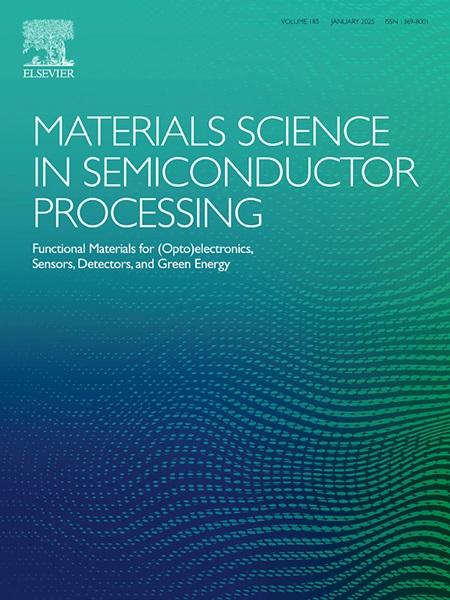Sm3+离子掺杂BaZrO3纳米荧光粉光电应用的固有特性研究
IF 4.2
3区 工程技术
Q2 ENGINEERING, ELECTRICAL & ELECTRONIC
引用次数: 0
摘要
在这项研究中,我们报道了未掺杂和掺杂钐(Sm3+)的锆酸钡(BaZrO3)纳米荧光粉的合成和综合表征,这些纳米荧光粉具有不同的Sm3+浓度(2、5和10 wt%),通过溶胶-凝胶自燃烧方法制备。这项工作的主要目的是开发高性能,Sm3+活化的BaZrO3纳米荧光粉,具有增强的光学和电学功能,用于下一代光电应用。虽然BaZrO3以其热稳定性和介电性能而闻名,但其作为稀土(RE)掺杂发光材料的宿主基质的潜力仍未得到充分开发。本研究试图通过研究Sm3+掺杂的BaZrO3纳米荧光粉的结构、光学和介电响应来填补这一空白。采用一套先进的分析技术来阐明合成的纳米荧光粉的物理化学性质。x射线衍射(XRD)证实了相纯度,并发现随着Sm3+掺杂浓度的增加,晶体尺寸从47 nm减小到20 nm。傅里叶变换红外光谱(FTIR)和拉曼光谱验证了宿主掺杂体系的振动特性和局部键合环境。利用能量色散x射线光谱(EDX)检测元素分布。高分辨率透射电镜(HRTEM)证实了纳米尺度的尺寸和适度的团聚。介电光谱和阻抗分析表明,离子电导率随着体积电阻的降低而提高,这表明了固态电解质应用的潜力。利用紫外-可见漫反射光谱(UV-Vis DRS)进行的光学研究表明,Sm3+掺杂浓度使纳米荧光粉的带隙值从3.64 eV降低到3.52 eV,从而提高了制备的纳米荧光粉的光学性能。此外,403 nm激发下的光致发光(PL)光谱显示了540 nm(绿色)、600 nm(橙红色)和644 nm(红色)三个强发射波段。值得注意的是,10 wt%掺杂Sm3+的纳米荧光粉显示出90.57%的高颜色纯度,强调其适合高质量的发光应用。这项工作的新颖之处在于将Sm3+策略性地掺杂到BaZrO3晶格中,同时调整其光致发光和电行为,这种方法扩展了这种钙钛矿材料的多功能能力。这些发现表明,Sm3+掺杂的BaZrO3纳米荧光粉是一种很有前途的光电子器件材料,特别是在固态照明和显示技术中。本文章由计算机程序翻译,如有差异,请以英文原文为准。

Twitching inherent properties of Sm3+ ions doped BaZrO3 nanophosphors for optoelectronic application
In this study, we report the synthesis and comprehensive characterization of undoped and samarium (Sm3+) doped barium zirconate (BaZrO3) nanophosphors with varying Sm3+ concentrations (2, 5, and 10 wt%), prepared via the sol-gel auto-combustion method. The primary aim of this work is to develop high-performance, Sm3+-activated BaZrO3 nanophosphors with enhanced optical and electrical functionalities for next-generation optoelectronic applications. Though BaZrO3 is well known for its thermal stability and dielectric properties, its potential as a host matrix for rare-earth (RE) doped luminescent materials remains underexplored. This study seeks to fill that gap by investigating the structural, optical, and dielectric response of Sm3+-incorporated BaZrO3 nanophosphors. A suite of advanced analytical techniques was employed to elucidate the physicochemical properties of the synthesized nanophosphors. X-ray diffraction (XRD) confirmed the phase purity and revealed a decreasing crystallite size from 47 nm to 20 nm with Sm3+ doping concentration. Fourier-transform infrared (FTIR) and Raman spectroscopy validated the vibrational characteristics and local bonding environment of the host-dopant system. Elemental distribution were examined using energy dispersive X-ray spectroscopy (EDX). High-resolution transmission electron microscopy (HRTEM) confirmed the nanoscale dimensions and moderate agglomeration. Dielectric spectroscopy and impedance analysis demonstrated that ionic conductivity improved with reduced bulk resistance, indicating potential for solid-state electrolyte applications. Optical studies using ultraviolet–visible diffuse reflectance spectroscopy (UV–Vis DRS) revealed a decrease in bandgap values from 3.64 eV to 3.52 eV with Sm3+ doping concentration, thereby enhancing the optical properties of prepared nanophosphors. Furthermore, photoluminescence (PL) spectroscopy under 403 nm excitation revealed three intense emission bands at 540 nm (green), 600 nm (orange-red), and 644 nm (red). Notably, the 10 wt% Sm3+ doped nanophosphors exhibited a high colour purity of 90.57 %, emphasizing its suitability for high-quality luminescent applications. The novelty of this work lies in the strategic doping of Sm3+ into the BaZrO3 lattice to simultaneously tailor its photoluminescent and electrical behaviour, an approach that expands the multifunctional capabilities of this perovskite material. These findings suggest that Sm3+ doped BaZrO3 nanophosphors act as a promising material for applications in optoelectronic devices, particularly in solid-state lighting and display technologies.
求助全文
通过发布文献求助,成功后即可免费获取论文全文。
去求助
来源期刊

Materials Science in Semiconductor Processing
工程技术-材料科学:综合
CiteScore
8.00
自引率
4.90%
发文量
780
审稿时长
42 days
期刊介绍:
Materials Science in Semiconductor Processing provides a unique forum for the discussion of novel processing, applications and theoretical studies of functional materials and devices for (opto)electronics, sensors, detectors, biotechnology and green energy.
Each issue will aim to provide a snapshot of current insights, new achievements, breakthroughs and future trends in such diverse fields as microelectronics, energy conversion and storage, communications, biotechnology, (photo)catalysis, nano- and thin-film technology, hybrid and composite materials, chemical processing, vapor-phase deposition, device fabrication, and modelling, which are the backbone of advanced semiconductor processing and applications.
Coverage will include: advanced lithography for submicron devices; etching and related topics; ion implantation; damage evolution and related issues; plasma and thermal CVD; rapid thermal processing; advanced metallization and interconnect schemes; thin dielectric layers, oxidation; sol-gel processing; chemical bath and (electro)chemical deposition; compound semiconductor processing; new non-oxide materials and their applications; (macro)molecular and hybrid materials; molecular dynamics, ab-initio methods, Monte Carlo, etc.; new materials and processes for discrete and integrated circuits; magnetic materials and spintronics; heterostructures and quantum devices; engineering of the electrical and optical properties of semiconductors; crystal growth mechanisms; reliability, defect density, intrinsic impurities and defects.
 求助内容:
求助内容: 应助结果提醒方式:
应助结果提醒方式:


